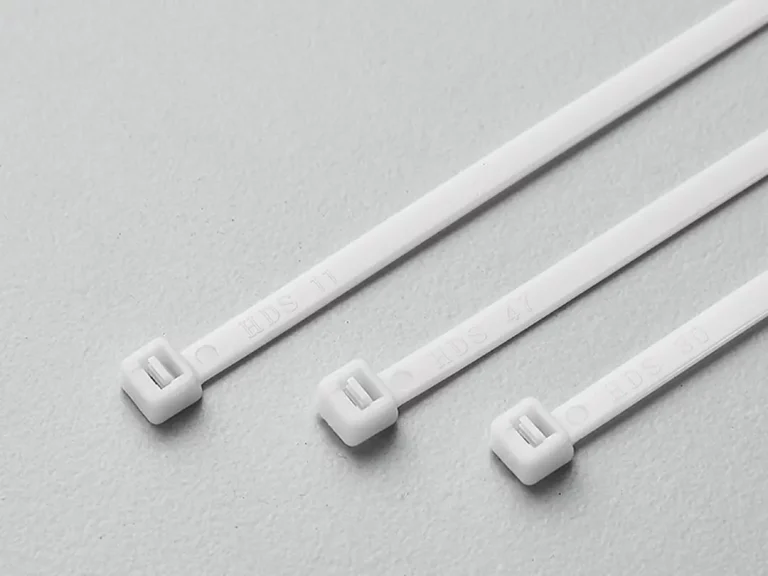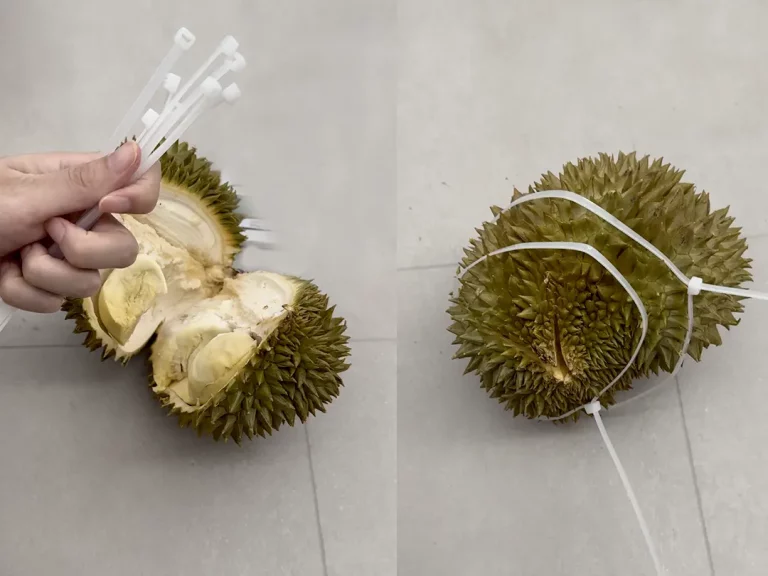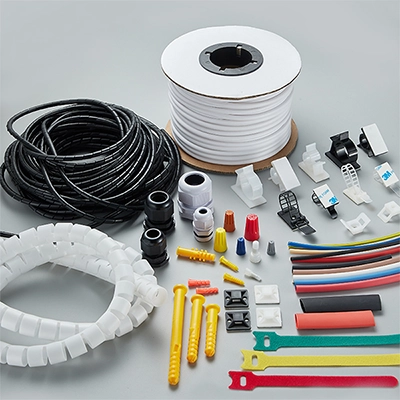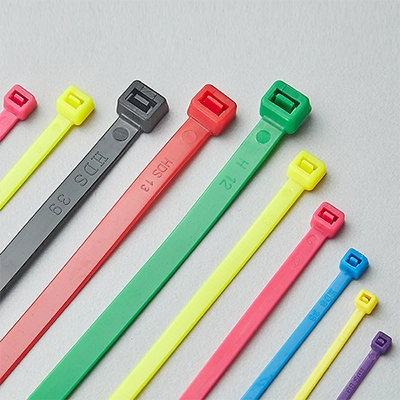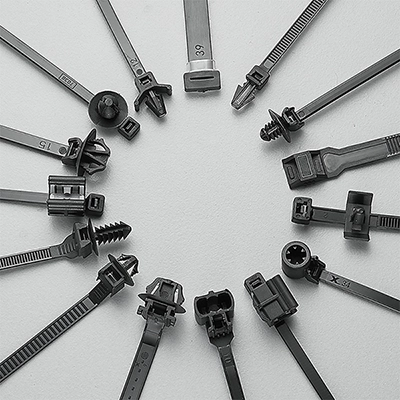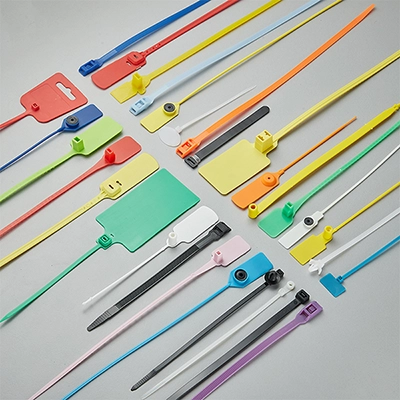
In this article, we aim to introduce 9 Different Types of Cable Ties, highlighting their unique functions and applications.
Cable ties, made from PA66, may seem like simple tools, but they come in a wide range of types, each designed for specific purposes. From managing wires to aiding in general organization, the diverse applications have led to the development of specialized cable ties. These include push mount, identification, and screw mount types. Let’s delve into each type, understanding their use cases.
1. Standard Cable Ties

Standard cable ties, often referred to as self-locking or plastic cable ties, are the most frequently used type. They are multi-purpose tools, extensively used for managing wires, organizing everyday items, and fulfilling various temporary fastening requirements. With lengths ranging from 60mm to 1500mm, they cater to most needs, offering a practical solution for a multitude of scenarios.
2. Push Mount Cable Ties

Push mount cable ties, as the name suggests, are a type of cable tie designed for both bundling cables and securing them to a surface. Push mount cable ties have a built-in mounting device that can allow the cable tie to be easily attached to a pre-drilled hole on a surface, such as a wall, panel, or chassis. Once inserted, the push mount secures the tie in place, ensuring that the bundled cables are firmly anchored.
Application
- This dual functionality makes push mount cable ties particularly useful in applications where cable management needs to be neat and secure, and where cables must be fixed to a specific location.
- In automotive or mechanical equipment, vibrations from handling or operation can cause wires and connectors to shift, leading to collisions or abrasions against the casing. Push mount cable ties offer a solid solution to keep these lines in place, minimizing movement and potential damage.
3. Cable Tag Tie

Cable Tag Ties, also known as zip tie tags, Zip Tie Labels, or cable tie labels. They combine the functionalities of bundling and labeling. These ties are distinctive for having a dedicated label area on the strap or head, which can be used to write labels or information. This feature facilitates easy identification and management of bundled items.
Application
- Labeling Wires and Cables: In electrical installations and network cabling, Cable Tag ties are invaluable for marking different cables based on their function or destination, aiding in maintenance and troubleshooting.
- Item Management: In logistics, storage, and office settings, these zip tie labels are used for identifying and categorizing various items, such as labeling files, equipment, and more. This helps in organizing and efficiently managing resources.
4. Screw Mount Cable Ties

Screw mount cable ties, also known as zip tie screw mount, are specifically designed to anchor or suspend cables, wires, and other items in designated locations. The defining feature of these ties is the additional hole in the head, which allows for the tie to be secured to walls, panels, or other surfaces using screws or nails.
Application
- Wire and Cable Management: In electrical engineering projects, data centers, or home wire management, screw mount ties are ideal for neatly securing wires or cables to surfaces. This organization enhances the neatness and safety of wiring systems.
- Securing Lightweight Items: In office spaces, warehouses, or workshops, these cable ties are used to hang or fix lightweight items such as tools, pipes, signs, and more, ensuring a tidy and organized environment.
5. Reusable Cable Ties

Reusable cable ties differ from the traditional design of cable ties, one-time use, in that they can be reused and adjusted. The design of these cable ties allows the user to loosen and retighten them as needed, making them a versatile choice for various applications.
Application
- Wire and Cable Management: Reusable cable ties are ideal for situations where wire routes need frequent adjustments or replacements, such as in electrical panels, computers, and audio equipment.
- Temporary Fixation and Organization: These ties provide a convenient solution for organizing and securing items temporarily, be it for event setups, temporary exhibitions, or daily household tasks.
- Relocation and Packaging: During moving or transportation, releasable cable ties can be used to bundle items securely and then loosened for reuse, enhancing efficiency.
- Greenhouse Applications: In modern greenhouse farming, where cable ties are used for constructing and maintaining greenhouse structures, the need to frequently open and close the greenhouse makes reusable cable ties extremely useful. Their reusability and ease of adjustment make them ideal for securing greenhouse coverings and frameworks, allowing for easy access and modification as needed.
6. Low Profile Cable Ties
Low profile cable ties are typically used in children’s play areas, such as indoor playgrounds or soft play equipment, to ensure the safety and stability of the structures. Unlike standard cable ties, low profile ties are designed to be fastened like a belt, threading the tail end of the tie through the head at a 180-degree angle, that’s why it is also called in-line cable ties. This ensures a snug and secure fit around the bound object.
Application
- The design of low profile cable ties makes them highly suitable for use in children’s playgrounds and other settings where enhanced safety measures are essential. Their unique fastening method minimizes protrusion and sharp edges, making them a safer choice in environments frequented by active children.
7. Double Locking Cable Ties
Double locking cable ties bear some similarity to low profile cable ties in their fastening style, resembling the way a belt is tightened. Unlike the traditional protruding lock mechanism of standard nylon cable ties, this design ensures a smoother surface post-binding. The flatter locking area of these ties reduces friction and potential damage to the items they secure.
Application
- Securing electrical cables and wires: Double locking cable ties’s unique dual-locking design ensures a robust and reliable fastening, particularly crucial in demanding environments. The cable tie’s serrated surface enhances grip, maintaining a firm hold even under high tension. This makes them an excellent choice for cable installation in industrial settings.
8. Zip Tie Handcuffs
As the name suggests, zip tie handcuffs, can form two loop structures, resembling the shape of handcuffs, and are used to secure either two hands or two separate groups of objects.
Application
- Law Enforcement and Security: In situations where police or security personnel need to temporarily control suspects or individuals causing disturbances, zip tie handcuffs offer a portable and rapid solution for restraint.
- Temporary Restraint: In unconventional law enforcement or control scenarios, zip tie handcuffs can serve as an alternative to traditional handcuffs, providing an effective temporary means of restraint.
9. Double loop Cable Ties

Double loop cable ties feature two locking heads on a single cable tie, offering a unique advantage: the ability to secure two separate objects simultaneously or to affix a single object at two distinct points. This design enhances both efficiency and stability in various applications.
Application
- Segmented Bundling: Ideal for organizing and securing wires or pipes along specific routes. By allowing separation and fixation, these ties enhance the overall organization and stability of the bundled items.
Different Types of Cable Ties
Cable ties are essential, versatile tools that serve far more than just basic tying needs. They adapt to a wide range of uses, from everyday organization to industrial tasks. These different types of cable ties come in various forms, including standard, push mount, and double loop, each designed for specific applications. Known for their strength, flexibility, and affordability, cable ties are vital for efficiency and order in numerous settings.

